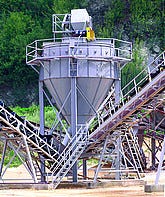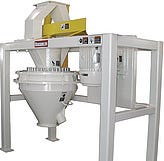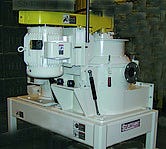Milling Semi-Abrasive Minerals
May 12, 2011
By Steve Coulombe, Sturtevant
|
Fourteen-foot Sturtevant air classifier used in the operation of a closed-circuit with ball mill |
Optimum milling solutions begin with choosing the right mill. In consultation with the mill manufacturer, selecting the right mill involves careful consideration of the application parameters (in this case, materials generally in the 2 to 4 mohs hardness range and up to 500 tn/hr capacity) and the various mill types available – from media or ball mills, cage mills, and hammer mills, to pin mills and air classification mills, with particular attention to all the wear part options. Below I examine how each of these choices affects four key factors: the initial capital investment, internal wear part needs, milling duration time requirements, and power consumption.
Media or Ball Mills
For high-capacity semi-abrasive mineral grinding (and though well suited to grinding highly-abrasive materials), the media mill is often thought of as the “go-to” answer. However, its ability to effectively meet all four of the key factors is arguable when processing only a semi-abrasive material or mineral. While its power consumption (5 to 20 kwh/ton depending upon application) and capital costs ($100,000 to $1 million USD depending upon capacity) appear fairly reasonable, its return-on-investment potential may be spread over a long time period. Media mill processing time (8- to 24-hr batch process with 10- to 500-tn/hr) is significantly longer than that of some of the other mill types. This may not always work for operations that require a shorter process time. Although mills exist for continuous processing, the residence time remains a limiting factor. Certainly coupling a ball mill with an air classifier is one way to improve the process efficiency, as commonly seen in the cement industry, but this adds complexity and drives up capital cost.
In the case of low-value commodities and providing that media contamination is not an issue, a media mill may indeed make sense due to its robust engineering and the fact that its actual grinding media can be replaced when required at relatively low costs. Media costs range from $1000 to $10,000 per year on small to mid-sized mills (not including periodic liner replacement cost) in a 24/7 operation depending upon the application and media type selected. Where higher capacities are concerned, the higher cost of a media or ball mill coupled with an air classifier, which pulls out fines and minimizes HP consumption, may still make sense, but other options exist.
Cage Mills
When milling low- to medium-value minerals, or in applications that do not require fine grinding, the cage mill may often be a good choice. Its capital cost ($25,000 to $150,000 for medium sized mills in a non-stainless steel contact design) is moderate and it offers advantages in wear part life due to tungsten carbide or cobalt tipped surfaces which deliver long-term reliable performance. Wear part costs, based upon selection, add an additional $10,000 to $30,000. Although second to a ball mill in available process capacity, a cage mill is a much quicker process. The cage mill offers continuous processing in volumes up to 50 tn/hr for medium-sized mills, while rating well in power consumption (2 to 5 kwh/ton depending upon application) relative to its output. Operational costs, other than power consumption, range from $5000 to $15,000 yearly depending upon the application and the wear protection level selected.
|
Sturtevant number 5 hammer mill |
Hammer Mills
The hammer mill is similar in many respects to the cage mill, except that a hammer mill cannot handle moist or fat bearing material. Depending upon the application, the hammer mill generally lends itself best to grinding to a more coarse size product. This is because when grinding to finer product sizes its screens may incur blinding, resulting in increased maintenance downtime. However, even with that involved, (and depending on the product size being produced) the hammer mill is often viewed as a cost-effective approach. The dollar amount of both the initial capital expenditure and operational costs (power use and wear part replacement) are fairly low per ton of output obtained.
|
Sturtevant Simpactor number 6 pin mill |
Pin Mills
The pin mill is a choice that hits all four key factors optimally. Importantly, the pin mill – especially those with a vertical shaft and a horizontal rotor that can be gravity fed or just blown straight through – offers a relatively low capital cost. Pin mills can easily be fitted with fully interchangeable and replaceable wear parts with surfaces hardened to 60 Rc, or can be fitted with 1/8-in.-thick tungsten carbide or cobalt tips. Also, a pin mill grinds very quickly as a once-through operation, and at capacities up to 50 tn/hr on a 250-hp unit. Its energy consumption (2 to 5 kwh/tn depending upon application) is easily justified if milling a medium-value material. Generally, a pin mill is a sensible choice in applications with a 5- to 8-percent silica content, and with maximum wear protection installed. The pin mill compares favorably to the cage mill in these applications.
|
Sturtevant Powderizer air classification mill model #2 |
Air Classification Mills
The air classification mill is suited to a finer grind application and a higher value material or end product than that tackled by the pin mill, for example. While similar to the latter mill type, the air classification mill is significantly more costly. With a complete product collection system included, the unit is priced at up to $350,000 for a non-stainless steel contact design, which features a 10 tn/hr system that includes a mill, feeder, baghouse product collector, valves, and controls. Depending upon wear part level selection, add on $10,000 to $30,000, and note that the classifier wheel replacement is an additional high cost. Power consumption is 10 to 20 kwh/tn. If the value of the final ground product is high enough, and the material is not abrasive to the point that a ball mill must be used, an air classification mill is a good choice.
When considering milling any semi-abrasive material or mineral, wear protection becomes critical, regardless of which mill is chosen. A pin mill lends itself best to these applications because the wear protection selection is so broad, that an ideal combination can be found to suit a variety of budget considerations. Below are some wear material examples to help with proper selection.
Wear Part Option Levels – from Mild to Best
• Mild steel for soft minerals such as clay or talc with no silica
• Tool steel hardened to 45 Rc for soft minerals with 0.5% or less silica or abrasive grit
• Tool steel case hardened to 60 Rc for same application as above but offering longer wear life (1 to 2 years in a 24/7 operation); or for handing applications with up to 1.5% silica or abrasives
• Chrome oxide coated for same application as above, but offering longer wear life (2 years or more in a 24/7 operation)
• Tungsten carbide thermal spray for same application as above but used for intricate parts
• Chrome carbide weldment for same application as above but used for severe wear areas such as under the pin impactors inside a pin mill
• Ceramics/high wear level (offering 3 years or more depending upon application) for final products or materials that cannot be contaminated by the mill, which must be protected from external tramp metal or large stones
• Tungsten carbide/cobalt clad (offering 3-plus years depending upon application) for final products that accept slight contamination by the mill, which like above, must be protected from external tramp metal or large stones
When milling semi-abrasive minerals, optimize your size reduction solutions by selecting the proper mill. Evaluate each mill type according to application parameters, and consider how a particular choice stands up to the four key factors outlined. This will ensure that your capital investment and operating costs are right on the money.
Steve Coulombe, is a six-year veteran of Sturtevant Inc. (Hanover, MA) and is the product manager for the Sturtevant Simpactor and Powderizer impact mills. Coulombe has a BSME degree from Northeastern University and more than 20 years of experience with dry powder applications and process equipment. For more information, visit www.sturtevantinc.com.
You May Also Like






